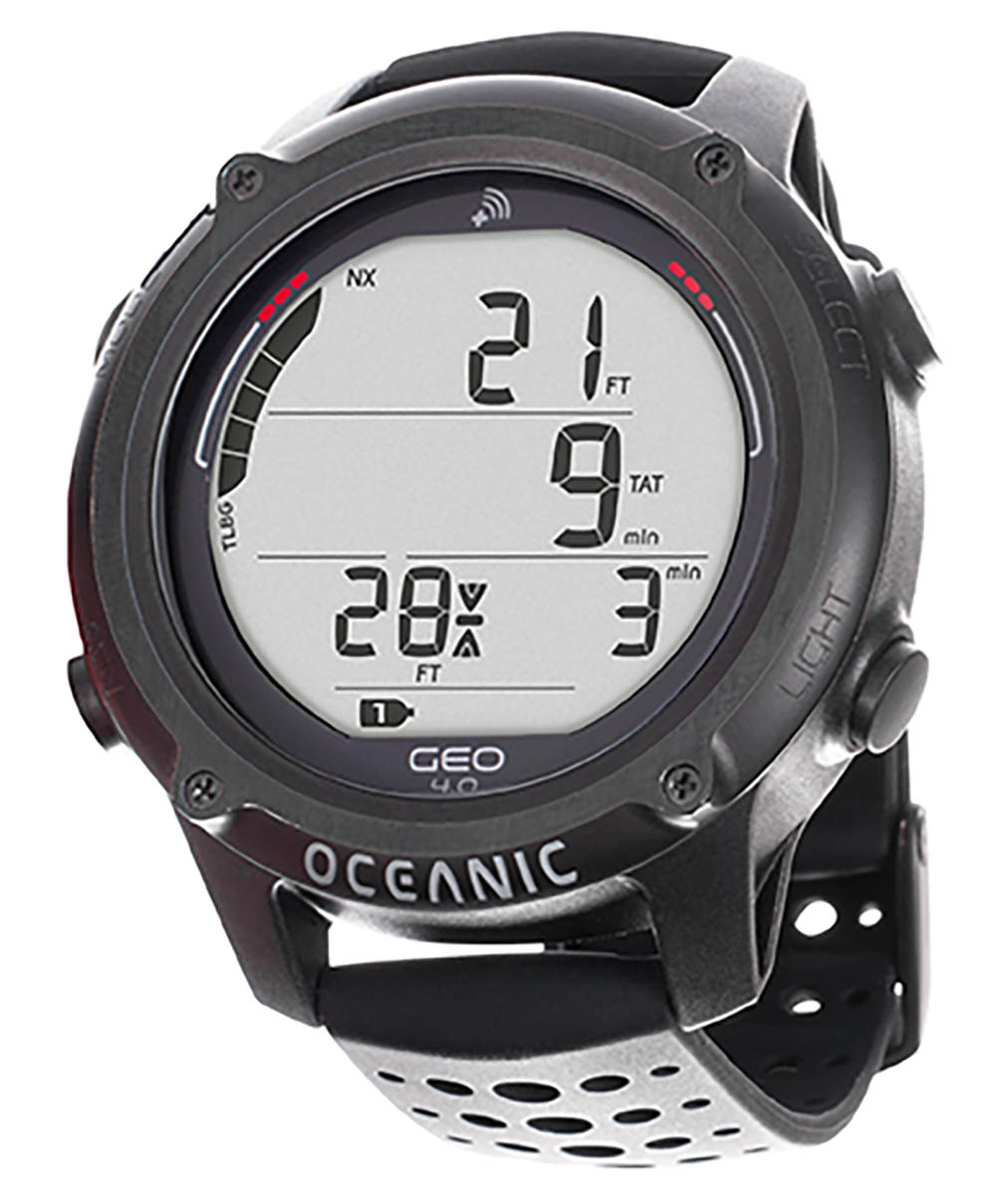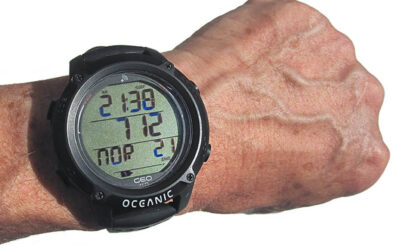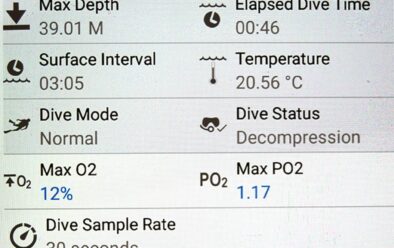Oceanic Geo4

Appeared in DIVER August 2019
My first dive computer cost £313, a sufficiently odd price for it to stick in my mind, and it revolutionised my diving.
Like the rest of the club I’d been using the BSAC 88 tables, and while it’s possible to plan a multi-level profile with them, it’s actually quite difficult if you don’t know how deep you’re going or the site you’re going to dive before you leave.
This might sound odd, but my club dived the Farne Islands a lot and the final choice of site was made on the day, based on factors such as where the boat-driver fancied going, where other clubs were diving and how much more chugging around the divers onboard could take before everyone heaved.
In those conditions it’s tough to know if you’re going to 20m or 30m or, sometimes, stay shallow enough to need only a snorkel, so there was a lot of use of the submersible tables that came with the 88 set. And I forgot to reset the bezel on my diving watch a lot too, so had to add guesswork to the overall calculation. Those were the days.
Using the computer, I could just drop in, keep an eye on my depth and gas and surface safely without having to worry about transfer tables, C codes or anything like that, and especially without worrying about setting my blasted watch.
I used my new computer for the first time at Scapa Flow, and very quickly realised that by moving a bit shallower, and then shallower still as the dive progressed, I could extend my dive-time considerably without the mandatory deco required by others still on tables.
Well, I could as soon as I got a buddy who also had a computer.
I mention all this because that £313 computer was air only, sampled data at three-minute intervals, was accessed using three fingers that you licked and touched to recessed pins to interrogate, and was a world away in terms of features and usability from the similarly priced Oceanic Geo4 I’ve just been using.
In other ways, however, the Geo 4 was a 21st-century version of my first computer, and I found myself using it as though I’d owned it for years.
I’m not sure that Oceanic will like the comparison, but it is meant as a compliment.
The Design
The Geo4 is a watch-style dive computer that comes with two different-length straps, so it’ll fit your wrist or around the cuff of your drysuit.
It’s powered by a user-replaceable battery, and there’s a special tool in the box for changing it.
Also in the box is a clear glass protector film to cover the face of the computer and provide protection against scratches, and a Quick Start guide that I did need to check very early on.
The unit is supplied in a state of hibernation and needs to be woken up by pressing the right buttons. After two minutes of futile and increasingly annoyed and frantic button pushing, I did a very non-male thing and read the instructions to discover which the right buttons to press actually were. After that, everything was sweetness and light.
I then downloaded the full manual and, of course, hardly needed it.
My Geo4 was all-black, though it also comes in white and there are five optional coloured straps. It sat on my wrist quite comfortably.
 I don’t wear a wristwatch normally but didn’t find myself noticing it in everyday wear, except when I needed the time. Given that the Geo4 is a decent size, that’s good.
I don’t wear a wristwatch normally but didn’t find myself noticing it in everyday wear, except when I needed the time. Given that the Geo4 is a decent size, that’s good.
The model essentially has two operating modes, Watch/Time and Dive. If you’re in Watch mode, a long press of the appropriate button takes you to Dive mode, and vice versa.
Once in the relevant mode, you can select parameters to adjust, scroll up and down menus to select values and confirm settings with ease.
My first reservation about watch-style computers is that they are often less intuitive to use than wrist-style computers, but clearly the team at Oceanic thinks like I do, because I had no problems at all with the Geo4.
Functions
In Time mode you can set day, date and time, in US or UK formats and, using 12- or 24-hour notation, set a variety of alarms.
You can even display two time zones if travelling, so the daily call home can be timed to cause minimum annoyance.
This is a two-gas – air and nitrox – computer, so will more than cover the diving requirements of most divers, few of whom use more than one gas-mix per dive. You can pre-set depth and time alarms, or switch them off, turn deep stops and safety stops on and off and lots more, customising the Geo4 to suit your style of diving, and can use it as a back-up in Gauge mode or to monitor your freediving.
Download the free DiverLog+ app and you can sync your phone or other mobile device to your Geo4 via Bluetooth and make all your adjustments from your device, as well as downloading dives for logging.
I did this, and it works very well, but once I had the computer set up as I wanted it I found it easier and quicker to adjust gas-mixes using the buttons on the computer. Being somewhat Luddite, I found that immensely satisfying.
You can set gases containing from 21% to 100% oxygen, so a bottom gas of air and a deco gas containing a higher proportion of oxygen is easily managed.
I used the Geo4 on a Red Sea trip, monitoring deco status for a single back-mounted 12-litre cylinder and then as a two-mix unit, when I supplemented that with a second bottle clipped as a stage and containing a richer nitrox mix.
It was easy to integrate setting the computer with checking the gas(es) in my tanks, adding very little to the pre-dive testing time.
In Use
In the water the data provided was very clear and easily read. My second reservation about watch size units is that the numbers can look weeny at a glance, but this display was clearly legible, with all the info you need and nothing you don’t.
Stray into mandatory deco and the display remained equally easy to interpret and use, with enough information to allow full control of the dive and the stops.
And, not being gas-integrated, you also need to be that bit more aware of what you’re doing and the gas supply remaining, something I prefer.
Gas-switching was a simple two-button process you can’t trigger by accident, and you can switch to either pre-set mix, provided the gas to which you’re switching is suitable for your current depth, as determined by the oxygen content and maximum allowable partial pressure you’ve set.
Switching back to your other gas is equally easy, if required, and an icon at the bottom of the screen tells you which gas the computer believes you’re breathing, so that you can check that you’re both on the same dive-plan.
Algorithms

On the subject of mandatory deco, the Geo4, like other Oceanic computers, offers a choice of two deco models, one more conservative than the other. Oceanic says that the DSAT model is based on the same data used in the PADI RDP and will impose restrictions on repetitive deco dives, while the Pelagic Z+ algorithm is Buhlmann ZHL-16c-based and more conservative overall.
Some very basic tables at the back of the Geo4 manual compare the two. The manual also suggests that Oceanic doesn’t recommend deep stops on decompression dives, which is where current deco theory seems to be headed.

Once you’ve selected an algorithm and made a dive you’re locked into using that algorithm until 24 hours after the final dive of your series, so you can’t change your mind midway through a liveaboard week, for example.
Not that I can see why you would. With either option you can choose to add extra conservatism into the settings.
For the record, I used the less-conservative DSAT model with no additional conservatism factored in, deep stops off and safety stops off.
I like my computers set to the bare bones of what will get me to the surface safely, and then to add in some padding myself, typically extending the shallower stops.
When we made three repetitive deco dives on the Rosalie Moller, the Geo4 gave me the stops I expected. I’ve dived that wreck a lot, so I’m pretty much dialled into the sort of deco likely to be required, and the Geo4 dished up no surprises.
Conclusion
This is a £300 watch-style computer, which is not a very expensive unit these days, but my only negative was the screen.
In a world of dive computers with colourful and permanently illuminated screens it’s a bit drab, with black digits on a grey background, so you’ll find you need to hit the appropriate button to switch on the inbuilt light when light levels drop, making the tracking of ascent rates and safety-stop depths trickier than otherwise.
But that’s it. The Oceanic Geo4 is a fine computer. It does everything it needs to and nothing it doesn’t. That simplicity might or might not appeal to you, but I really liked it and would be very happy with one on my wrist.

